
About UsThe Numismatic Bibliomania Society is a non-profit organization promoting numismatic literature. For more information please see our web site at coinbooks.org SubscriptionsThose wishing to become new E-Sylum subscribers (or wishing to Unsubscribe) can go to the following web page link MembershipThere is a membership application available on the web site Membership Application To join, print the application and return it with your check to the address printed on the application. Membership is only $15 to addresses in the U.S., $20 for First Class mail, and $25 elsewhere. For those without web access, write to: David M. Sundman, Secretary/TreasurerNumismatic Bibliomania
Society AsylumFor Asylum mailing address changes and other membership questions, contact David at this email address: dsundman@LittletonCoin.com SubmissionsTo submit items for publication in The E-Sylum, just Reply to this message, or write to the Editor at this address: whomren@coinlibrary.com
BUY THE BOOK BEFORE THE COINYou won't regret it! |
- WAYNE'S WORDS: THE E-SYLUM JANUARY 3, 2010
- NUMISMATIC LITERATURE DEALER JOHN BURNS AT THE 2010 F.U.N. SHOW
- REMINDER: STACK FAMILY NUMISMATIC LIBRARY SALE JANUARY 9, 2010
- BOOK REVIEW: THE AUTHORITATIVE REFERENCE ON LINCOLN CENTS, SECOND EDITION
- BOOK REVIEW: ALASKA AND YUKON TOKENS BY RON BENICE
- BOOK REVIEW: CHECK LIST AND RECORD BOOK OF UNITED STATES PAPER MONEY
- BOOK REVIEW: AGRICULTURAL AND MECHANICAL SOCIETY MEDALS OF THE U.S.
- MORE ON COINAGE OF THE ANGLO-HANNOVERIAN PERSONAL UNION 1714-1837
- STEVEN A. MIDDLETON 1952-2009
- THE SCHULMANS AND THE NAZI OCCUPATION OF THE NETHERLANDS
- AUSTRALIA'S MUSEUM VICTORIA MOUNTS ONLINE TOKEN EXHIBIT
- THE ASSOCIATION OF COLLECTING CLUBS
- 1933 SAINT-GAUDENS DOUBLE EAGLE DESTRUCTION DOCUMENTATION
- PHOTO: GREG STEMM AND MATT TUCKER WITH ODYSSEY MARINE TREASURE
- MORE ON THE PITTSBURG AND MEXICAN TIN MINING COMPANY MEDAL
- E-SYLUM READERS AT BINION'S HORSESHOW CASINO
- HOW DONATED LAS VEGAS CASINO CHIPS ARE PROCESSED
- A PLEA FOR GOLD MONEY
- U.S. COIN REPLICAS FROM NEAL SHERMAN'S MARYLAND MINT
- PETER ROSA'S COIN REPLICAS
- COIN DEALER TOM NOE'S CONVICTION UPHELD
- PARISIAN ROYAL AGRICULTURAL SOCIETY ATTENDANCE MEDALS
- ROMAN COIN FLIPPING: HEADS OR SHIPS
- ROYAL AUSTRALIAN MINT STRIKES CENTENNIAL COIN
- QUERY: JOSEPH WHARTON MEDALS
- ZIMBABWE NOTES IN THE NEWS AGAIN
- GOT CHANGE FOR A MILLION SILVER DOLLARS?
- MALAYSIAN BANKNOTE ERROR DISCOVERED
- AMAZON'S KINDLE MILESTONE: MORE E-BOOKS THAN REAL BOOKS SOLD ON CHRISTMAS
- FUNKY BOOKSHELVES
- FEATURED WEB PAGE: THE NEW YORK NUMISMATIC CLUB YEAR BOOK
WAYNE'S WORDS: THE E-SYLUM JANUARY 3, 2010

Among our new subscribers this week are Mitch Mitchell, Paul Cartmill, Chris Freeman, K. E. Sims, Phil Kurjan, And Philip Blette. Welcome aboard! We now have 1,299 subscribers.
Welcome to the Future. It's 2010 - so where's my jet-pack and personal robot assistant? Seriously, though, if anyone had told me in say, 1990 that by 2010 I'd be editing a gazillion pages of numismatic content weekly I'd have looked at them like they had three heads. But I *do* have a robot army of sorts, in the various computer productivity tools that have emerged.
First is the personal computer itself, followed by the Internet. Put them together and one person can publish content to thousands of subscribers and the whole damn world with the click of a mouse. Sure beats the old days of laying out pages by hand, taking a master copy to a printer, stuffing envelopes and schlepping to the post office.
Other tools like our Flickr image archive make editing and publishing photos a snap. And having the world's newspapers online and searchable instantly gives me an army of reporters and photographers to draw from. Not to mention our readers, all available to me via email from everywhere in the world, which constitute the best collection of numismatic talent anywhere.
Combine this with the news from Amazon that on Christmas, the company sold more Kindle books than physical books, and I guess, just maybe, The Future has arrived.
This week we open with Florida travel plans and MULTIPLE great book reviews. Other topics include the Schulman coin dealer family and the Nazi occupation of Amsterdam, coin replicas of Peter Rosa and Neal Sherman, medals honoring Joseph Wharton, and more.
To learn about Parisian royal agricultural society attendance medals, coin flipping in Roman times, and a million-dollar U.S. banknote, read on.
Wayne Homren
Numismatic Bibliomania Society
NUMISMATIC LITERATURE DEALER JOHN BURNS AT THE 2010 F.U.N. SHOW
Numismatic literature dealer John H. Burns writes:
I will be set up at tables 1247 and 1249 at the F.U.N. show January 7 to January 10.
Also heading to F.U.N. is Alan V. Weinberg, who writes:
I'm off to Orlando on Tuesday night. Upon my return, I'll send a report on the sale or non-sale of the 1913 Liberty nickel. Frankly, I don't think it'll go past 3 million hammer - in this economy - and thus won't sell. Heck, you can buy a choice gold Brasher doubloon (the Kagin-Contursi specimen or Virgil Brand-Jack Friedberg-Walter Perschke specimen - both currently on the market) for $5 million and neither is moving. The Brasher Doubloon's aesthetics, historical desirability and sale appearance frequency puts the 1913 nickel to shame.
I'd love to be proven wrong and have the nickel sell for, say, $5 million, but I don't think so. It's nickel, small and visually unimpressive, not a gem coin, part of a series with only the last date digit difference, historically unimportant, and a sub-rosa Mint product.
REMINDER: STACK FAMILY NUMISMATIC LIBRARY SALE JANUARY 9, 2010
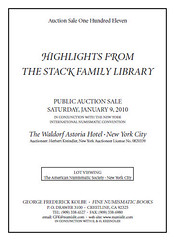 On January 9th, 2010, George Frederick Kolbe/Fine Numismatic Books will offer for sale at public auction highlights from the remarkable numismatic library carefully assembled over seven decades by the New York numismatic firm founded by brothers Morton and Joseph and ably carried on by Norman, Benjamin, Harvey, Susan, and Lawrence Stack.
On January 9th, 2010, George Frederick Kolbe/Fine Numismatic Books will offer for sale at public auction highlights from the remarkable numismatic library carefully assembled over seven decades by the New York numismatic firm founded by brothers Morton and Joseph and ably carried on by Norman, Benjamin, Harvey, Susan, and Lawrence Stack.
For over fifty years, the fabled American portion of the library has resided in antique bookcases lining one wall of Harvey Stack's office, and along the opposite wall as well. Other portions of the library were, for many years, located throughout the main floor of the firm's New York City retail location at 123 West 57th Street and many of the great classic works on ancient and foreign coins and medals were carefully arranged on the second floor in the Coin Galleries offices.
Covering virtually all aspects of numismatics and replete with rarities, it is one of the finest working libraries on numismatics ever formed in the United States.
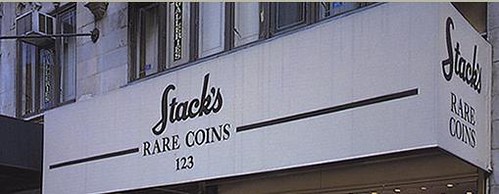
Key works from this magnificent library will be sold at the Waldorf Astoria Hotel in New York City in conjunction with the New York International Numismatic Convention this coming January. The profusely illustrated catalogue will be arranged in two parts: 190 lots of rare and classic works on American coins, medals, and tokens, and 210 key works on ancient, medieval, and modern numismatics.
Lot viewing will be held at the American Numismatic Society, 75 Varick Street, 11th Floor, New York, NY 10013. On Thursday, January 7th, lot viewing will be from 8 AM until 7 PM and on Friday, January 8th, from 8 AM to 8 PM. The auction itself, as previously mentioned, will be held at the Waldorf Astoria Hotel, 301 Park Avenue between East 49th & 50th Streets, New York, NY 10022.
Some American highlights include: the Stack firm's own complete bound set of their auction sale catalogues, comprising an unparalleled source of data on rare American coins, medals, tokens, and paper money; a photographic record of the fabled collection of $2.50, $5.00, and $10.00 United States gold coins from the collection of Colonel E. H. R. Green, housed in three handsome leather-bound volumes and original inventories and financial details of the collection; inventories of the incomparable Louis Eliasberg collection; most of the Chapman brothers auction sale catalogues issued with original photographic plates; classic works on large cents from the library of legendary collector Henry Hines, often filled with letters and research notes assembled by the "Big Three of the Big Cents": Hines, Howard Newcomb, and George Clapp.
BOOK REVIEW: THE AUTHORITATIVE REFERENCE ON LINCOLN CENTS, SECOND EDITION
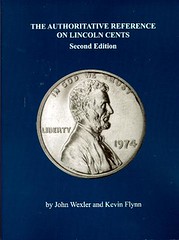 Every once in awhile, a numismatic book is written with the audience clearly in mind, and this is that tome. The Authoritative Reference on Lincoln Cents by John Wexler and Kevin Flynn was first written in 1996.
This second edition picks up nicely where that first edition left off and adds an immense amount of valuable material. The information presented encompasses a wide range of topics on the subject written by the authors and includes several additional articles contributed by well respected numismatists Jason Cuvelier, Michael Fahey, Jamie Hernandez, J.P. Martin, and B.J. Neff.
Every once in awhile, a numismatic book is written with the audience clearly in mind, and this is that tome. The Authoritative Reference on Lincoln Cents by John Wexler and Kevin Flynn was first written in 1996.
This second edition picks up nicely where that first edition left off and adds an immense amount of valuable material. The information presented encompasses a wide range of topics on the subject written by the authors and includes several additional articles contributed by well respected numismatists Jason Cuvelier, Michael Fahey, Jamie Hernandez, J.P. Martin, and B.J. Neff.
The reference begins with the history of the ubiquitous and highly collected Lincoln cent, from Victor David Brenner's iconic wheat back, up to and continuing with the words of Frank Gasparro; the man who designed the memorial cent. The history of the Lincoln cent is very interesting and Flynn and Wexler have not wasted any pages in the discussion. The history is followed by a very valuable section on how to use the book and the reader will need to come back to this reference often. The die variety reference system, cross referencing, identifying characteristics, and pricing guide are explained.
The next section contains important information on hub and transitional design changes, and a cross referencing section to help the novice as well as the advanced collector. The amount of changes within the Lincoln cent series could lend itself to a small type collection in and of itself. Speaking of collecting the there is also a detailed description of Lincoln cent grading with photographs and example specimen for both hub and transitional design changes.
The next two hundred or so pages of the volume will become the tomes pièce de résistance and encompass for die variety collectors what amounts to an almost complete study of the hobby. The Lincoln cent variety collector would be less effective without this reference and therefore The Authoritative Reference on Lincolns Cents Second Edition is a must have for the die variety collector. In the past this level of detail and study was left to a small branch of folks within the hobby. It had been the endeavor of very serious and meticulous individuals. However over the past few years this sector has become a very popular pastime for new and re- invigorated collectors. The possibility that a couple of hundred dollar Lincoln cent may be retrieved from pocket change can't hurt either.
In the next section is a well written article on "Trial Dies" by B.J. Neff. What is a trial die you might ask? Well if you must know they are a die variety much like a doubled die and more which is explained in detail by the authors. The articles that follow explain Lincoln cent authentication, doubled dies, repunched mintmarks, over mint marks, as well as transitional varieties and even give the reader an advance knowledge of where the hobby may be headed in the next few years. This is very well written for the advanced collector with an eye on the future of the coin market.
The authors have hit the bull's eye with this volume, it is fascinating and informative, and presents hundreds of photographs. Flynn and Wexler capitalize on the importance of die varieties in this volume and they do so in a methodical manner. The explanation of the die hub process is spot on and the section which explains the various types of hub issues affecting the planchet are detailed to a fine degree. This is one of the most fascinating aspects of the volume and enlightens the reader on the coin production process. This background material is the perfect way to lead into the subject of die varieties for which this volume might well just stake its claim as the seminal work to date on that subject. For my two cents this book is a must for the Lincoln cent collector. It is an easy book to find your way around and yet the amount of information presented is encyclopedic but more than often to the point.
The Authoritative Reference on Lincoln Cents Second Edition by John Wexler and Kevin Flynn can be found at either kevinjflynn.com or doubleddie.com/120501.html .
BOOK REVIEW: ALASKA AND YUKON TOKENS BY RON BENICE
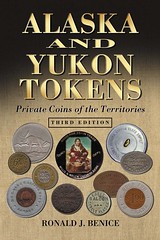 The third edition of Ron Benice's Alaska and Yukon Tokens has been released.
It was published by McFarland & Company, the price is $49.95 and can be purchased from them at www.mcfarlandpub.com or 1-336-246-4460.
The third edition of Ron Benice's Alaska and Yukon Tokens has been released.
It was published by McFarland & Company, the price is $49.95 and can be purchased from them at www.mcfarlandpub.com or 1-336-246-4460.
I have received a review copy and cannot express how pleased I am. Primarily, this reference lists pre-statehood Alaska tokens (some exceptions are noted). Added to this edition for the first time are tokens from Canada's Yukon Territory. As with all catalogues of this nature, they are never complete. New tokens will continue to appear. This is a great update on the previous edition.
It has been about 15 years since the second edition. Understandably, there are 55 new issuers and 239 previously unlisted tokens. Rather than re-number the entire catalogue as was done in the second edition, the use of decimals allows new issuers to be placed in alphabetical order. New tokens from previously known issuers are placed at the end of the series with a new letter designation.
The catalogue is profusely illustrated. While not all tokens are illustrated, the number of illustrations is more than sufficient. Major rarities are illustrated, as are most of the new issuers' tokens. When there are varieties, the tokens are illustrated, or at least described in such a manner that it is easy to distinguish between them.
The descriptions of token issuers are expanded and more period photos are used. This allows the reader to better grasp the historic value of the token.
Mavericks can be a problem area. When a maverick is generally accepted, because of overwhelming evidence to be from a certain location, it is included without special note. Others are shown as "attribution tentative" or "attribution speculative." When a token has a possible alternative attribution, Mr. Benice goes into detail to justify its inclusion or omission (Juneau comes to mind).
While the general scope of the catalogue is pre-statehood, all military tokens are included as they are still truly tokens. In the past 15 years, many previously unreported chits have surfaced. Most are of modest value, but there are exceptions.
Commercial fishing has played a huge role in the development of Alaska. Many of the rarest Alaska tokens are from these companies, and quite a number have come to light since the last edition. As with the military tokens, many chits used by these companies are now just becoming known and these are included.
Transportation tokens is another area where tokens from the statehood era are also listed. Most are common, but there are some rarities, and these are listed and illustrated. Food Stamp tokens are listed, but not illustrated. Prison tokens are included for the first time. Since Alaska is a small state, only a few are known. Mr. Benice feels this is a trial listing, and that perhaps more are out there. Rounding out the Alaska section are the Metallic Identification Chits, many issued by companies that also issued tokens. For others, it is the only metallic numismatic item from the company.
New to this edition are the listings for Yukon tokens. This is divided into two sections: metallic and modern plastic. Several Alaska issuers will also be found in the Yukon section. The history of the two territories was so intermeshed in the gold rush days that the Fourth of July was actually celebrated in Dawson, Yukon.
The addition of 239 new tokens is an achievement, but the changes in pricing since the last edition is really the significant change.
Pricing is always a controversial area. The values shown in the catalogue are based on sales records. Because of very limited sales records on the rarest items, this is not an easy task. Sellers will think values are too low, while buyers will think they are too high. In the 15 years since the second edition, prices have escalated dramatically. While I might have disagreement with Mr. Benice on individual items, overall, I believe he has done a good job balancing the real world with the hype.
Many rare tokens have been bringing astounding prices, but if another shows up, is that price going to hold? As Mr. Benice mentions, eBay has shown how common or scarce a token might really be. Those tokens from known hoards find their prices reduced in this edition. Truly scarce and rare tokens have seen significant increases in catalogue price. Common tokens remain inexpensive. Mid-range tokens have generally stayed the same, with a few moving up or down in value.
Mr. Benice has expressed a prejudice against cardboard tokens. Most of these tokens are priced at lower levels than a comparably rare metal token (composition is one of his criteria for establishing value). This is unfortunate because they are more subject to deterioration than metal tokens. It is good to see that the rarer of these have enjoyed a reasonable price increase.
A 14 page index caps off an excellent reference, making it simple to locate that token without a place name.
On the negative side, I have a few minor points.
The third edition is soft bound. Having grown accustomed to hard bound, and worn out a couple copies of the second edition, it seems that I will have to keep sufficient copies on hand just to replace those that I abuse.
Missing from this edition are the short, geographical descriptions of the cities, towns and villages. I think this will be missed. Many without an intimate knowledge of Alaska geography will be scrambling to a map to see where the tokens are from.
Food stamp tokens got a brief mention in the second edition. There is a complete listing in the third edition. However, there were more illustrated tokens in the previous edition. It would have been nice to have an obverse photo from each issuer for reference.
Catalogues like this are more than just a list of tokens. If you go beyond the tokens, and examine the issuers, you get an idea of the people who came to Alaska, rushed from gold rush to gold rush, and settled in the last frontier. Failure to recognize this as a commercial or mercantile history would be a mistake. While this catalogue is a must for token collectors, it also provides a look into the history of the territories as expressed by the merchants, hoteliers and saloon keepers.
Dick adds:
I expect my shipment to arrive in mid-January. I am preselling at $46, postpaid. Suggested retail is $49.95.
BOOK REVIEW: CHECK LIST AND RECORD BOOK OF UNITED STATES PAPER MONEY
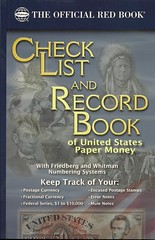 We were very pleased to see that Whitman Publishing, LLC has published a very nice check list and record book for United States paper money from 1861 to present. This soft bound book contains 248 pages and allows you to catalog your U. S. paper money collection utilizing the Friedberg and Whitman numbering systems. Each entry has a place for a check mark, as well as a space to list the grade and make other comments. This extra space for comments will be a great place to put important information regarding the notes in our (and your collection). You can list in the comment space: price paid, dealer name or auction purchase, serial number, date purchased, or other information such as a graded note.
We were very pleased to see that Whitman Publishing, LLC has published a very nice check list and record book for United States paper money from 1861 to present. This soft bound book contains 248 pages and allows you to catalog your U. S. paper money collection utilizing the Friedberg and Whitman numbering systems. Each entry has a place for a check mark, as well as a space to list the grade and make other comments. This extra space for comments will be a great place to put important information regarding the notes in our (and your collection). You can list in the comment space: price paid, dealer name or auction purchase, serial number, date purchased, or other information such as a graded note.
This check list and record book covers all federal issues from $1 to $10,000, fractional currency (including regular issues, specimen issues and shields), postage currency, encased postage stamps, mule notes (with many star numbers listed) and one page to list your errors. One page is also available for you to list your miscellaneous items such as War of 1812 issues, or other U. S. paper that might not be listed in this book. We especially liked seeing the printages of the notes along with rarity and extant of issues known. To say the least this is invaluable information and can actually be used when you are looking at auction catalogs, dealer stocks at their stores, coin shows or even the Internet.
Over the past 15 years we have seen many more dealers and collectors come into the market place for U. S. paper money. This reference has all the information you need regarding all issues and will assist you with your buying and selling of them. This will be another best seller for Whitman and is available from them for $9.95. For information on purchasing this check list and record book they may be contacted at: Whitman Publishing, LLC, 3101 Clairmont Road, Suite C, Atlanta, GA 30329 Phone No. (800) 546 – 2995 or visit their web page at www.whitmanbooks.com.
I agree that the book can be very useful for those who own collections of this material, but I was a little surprised to see a hardcopy checklist - it seems like an anachronism today, in an age where computers and spreadsheets rule the day. These kinds of checklists were popular decades ago, but I don't recall seeing one published in the last several years.
With the advent of the Smartphone (basically a small, handheld networked computer that happens to also make phone calls), I would think there would be a market for an application that implements the functions of a collector's checklist. This is an area I would encourage Whitman and other numismatic publishers to enter, perhaps through partnerships with seasoned phone app providers. Anybody got an app for that? Hope so! -Editor
BOOK REVIEW: AGRICULTURAL AND MECHANICAL SOCIETY MEDALS OF THE U.S.
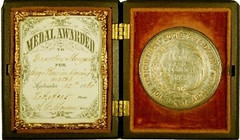 In a recent E-Sylum I reported the just-printed book by Andrew Harkness "Agricultural and Mechanical Society Award Medals of the United States" published by and available on only www.lulu.com At the time I had not yet received my copy and the book was almost completely unknown except for Joe Levine's advance copy from author Harkness.
In a recent E-Sylum I reported the just-printed book by Andrew Harkness "Agricultural and Mechanical Society Award Medals of the United States" published by and available on only www.lulu.com At the time I had not yet received my copy and the book was almost completely unknown except for Joe Levine's advance copy from author Harkness.
Well, I received it today and here are my comments. I was concerned that the book would arrived battered in the mail, all the way from New York City publisher lulu.com Not so. The Post Office-shipped large hard cardboard box with the book itself stabilized in the interior with sealed plastic wrap arrived in impeccable condition. The notoriously picky bibliophile John J. Ford, Jr. would have been pleased. I ordered it online a week ago and here it is in my hands.
The book is truly "eye-candy" . Only available in soft cover (I would have paid extra for a hard cover if there was one), this is the color version at $85. + $3.99 shipping + NY sales tax if shipped there. A quality book with quality paper, it is 198 pages of the most beautiful color U.S. medal photography you could hope for. There are 483 medals pictured obverse and reverse, all depicted actual diameter - totaling almost 1000 plates. Sharp, crisp & colorful, a 5x glass magnifies any detail without any intrusive dot pattern.
According to the Preface, author Andy Harkness started collecting this challenging series in 1969 and he's still going strong at 75 yrs. He has indisputably built the largest and finest collection of these local, state and federal mostly-handheld or "table " medals ever assembled and makes my smaller (but perhaps more select) collection of these (see www.neocollect.com for my collection) seem anemic by comparison. There are so many medals depicted in this reference that I'd give my eye-teeth for...so many pre-1900 large silver and gold medals totally hand-engraved and necessarily unique.
The subject matter and plated contents of the book will appeal to a broad spectrum of serious medal or diesinking collectors: U.S. mint medals, pre-1900 gold and silver medals, totally engraved medals, medals designed and die-sunk by specific firms or diesinkers like Lovett, Barber, Furst, etc, medals depicting famous people or animals like horses, livestock or machinery, medals from California, Utah or South Carolina or a collector's particular region or state. In my opinion collecting for 55 yrs, after seeing these medals, no reasonably astute collector can ever return to slabbed Morgan dollars or Saint-Gaudens double eagles.
Yes, the book - buy the color version and not the $35 b & w version - is fairly expensive at $85. I would have preferred to pay $50-$60 myself but lulu.com didn't plan on selling many books and the book, I understand, is literally assembled as orders come in- but promptly so and shipped . Yes, it would have been easy to designate the metal of each medal pictured and the millimeter diameter but there are very few where the reader is in doubt about whether the medal is silver or white metal and all medals are reportedly depicted actual size.
All things considered, this is a must-have for any serious collector of American medals or diesinkers and the only way to order it is on line through www.lulu.com in NYC. They don't even have an 800 number.
To read the earlier E-Sylum article, see: NEW BOOK: AGRICULTURAL AND MECHANICAL SOCIETY MEDALS OF THE U.S. (www.coinbooks.org/esylum_v12n51a05.html)
MORE ON COINAGE OF THE ANGLO-HANNOVERIAN PERSONAL UNION 1714-1837
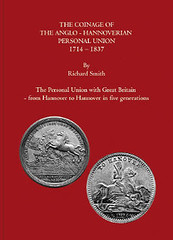 The last issue of The E-Sylum mentioned a new book, "Coinage of the Anglo-Hannoverian Personal Union 1714-1837" by Richard B. Smith. A just-received auction catalog from Fritz Rudolph Kuenker includes an ad with some additional info.
The last issue of The E-Sylum mentioned a new book, "Coinage of the Anglo-Hannoverian Personal Union 1714-1837" by Richard B. Smith. A just-received auction catalog from Fritz Rudolph Kuenker includes an ad with some additional info.
The book is in English, is 659 pages, ISBN 978-3-941357-01-03, and lists at 98 euros. Neither Amazon nor Abebooks listed the book today. I have a 1970 book "The Anglo-Hannoverian Coinage". by the same author. I hope the American Numismatic Association library gets the book so I can borrow it and determine whether it matches my interests enough to buy a copy and find bookshelf space, and pay the usually-expensive postage from Europe.
To read the earlier E-Sylum article, see: NEW BOOK: COINAGE OF THE ANGLO-HANNOVERIAN PERSONAL UNION 1714-1837 (www.coinbooks.org/esylum_v12n52a03.html)
THE BOOK BAZARRE
STEVEN A. MIDDLETON 1952-2009
I learned of the recent death of Steven Middleton through the 1-4-10 issue of Coin World. I knew him through his active involvement as an exhibitor and exhibit judge.
Steve was born on April 5, 1952, in Orange, New Jersey. He died on December 10, 2009, at the age of 57. He taught chemistry and physics at Orange High School and later Mount Olive. He occasionally wore a magician's cape as he demonstrated experiments. His dedication to teaching earned a teacher-of-the-year award.
In recent years Steve exhibited "Medals of the First Ferris Wheel". He won first place awards at FUN, Central States and the ANA. He won third place for best-of-show at the ANA in 2008. Selected items from his library are included in David Sklow's sale of 2-13-10.
The last time I saw Steve was at the 2009 Central States show. He gave me an elongated token with the invitation to the "Middleton Cocktail Party" at the ANA convention August 5, 2009, at the ANA Convention. I am sorry I could not attend.
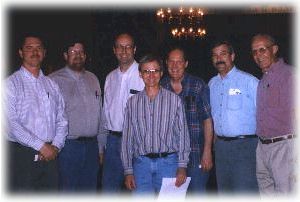
THE SCHULMANS AND THE NAZI OCCUPATION OF THE NETHERLANDS
I thought that was the most interesting paragraph in the entire Kolbe catalog review, as so many had wondered about the Schulman/Amsterdam WWII situation for so long.
Many numismatists over the years have wondered about how the Schulmans survived the Nazi invasion/occupation of the Netherlands. We all just assumed that some of the Nazi higher-ups collected rare coins and let the Schulmans live and carry on business to an extent. But this writeup by Hans in the notes of the Kolbe catalogue (Stack's library, lot 332) clears that notion up. Their father disappeared forever.
I have been to the shop on Keizersgracht on the canal afterwards when Jacques was dealing and bought an extraordinary cased 12oz .900 fine gold U.S. Presidential life saving medal awarded to a Dutch pirate captain in 1860 - and still have it.
Many hundreds of historical and informational tidbits and gossip of decades ago surfaced in the catalogue lot notes. Did you know that Hans and brother Jacques (of Amsterdam) Schulman's father "disappeared" and was never again heard from once "the brutal aggressors invaded the Netherlands in 1940" - written in 1945 where clearly Hans was yet so intimidated by use of the words "Nazi" and "Germany" that he skirted their use.
Alan adds:
The catalogue was like a box of chocolates - you can't stop. You put it aside and then must almost immediately return to it.
To read the earlier E-Sylum article, see: REVIEW: KOLBE STACK FAMILY LIBRARY AUCTION CATALOG (www.coinbooks.org/esylum_v12n52a06.html)
AUSTRALIA'S MUSEUM VICTORIA MOUNTS ONLINE TOKEN EXHIBIT
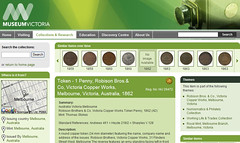 In reference to a new online exhibit at the Museum Victoria in Melbourne, Australia,
Dick Doty of the National Numismatic Collection at the Smithsonian writes:
In reference to a new online exhibit at the Museum Victoria in Melbourne, Australia,
Dick Doty of the National Numismatic Collection at the Smithsonian writes:
Please share this site with the brethren assembl'd. I think it's very good.
Dick forwarded the following note from John Sharples:
The token project I worked on (with others) a couple of years ago has now gone online at the museum - it is very good and includes histories of the issuers and mints as well as guidelines for identification of the different dies used by issuers etc. Please spread the word if you like what they have done - tell them too (they are counting hits and it will influence further numismatic on-line funding).
To view a sample page, see:
Token - 1 Penny, James Wallace, Grocer, Wellington, New Zealand, 1859
(museumvictoria.com.au/collections/items/52067/token-1-
penny-robison-bros-co-victoria-copper-works-melbourne-victoria-australia-1862)
Some of the web pages I tried to access were unavailable, but I did enjoy surfing through the site. One thing I learned than may be of interest to our U.S. readers is that "During World War II the US mints at San Francisco and Denver were contracted to strike silver coins, and the Indian mint at Bombay to strike bronze coins for Australia." -Editor
THE ASSOCIATION OF COLLECTING CLUBS
As we move into a new decade, it seems like a good time to take a look at collecting groups and the role they play in the antiques, art and collectibles industry.
APIC Announces Smithsonian Internship Program
The American Political Items Collectors (APIC) announce their 2010 Mark Jacobs Smithsonian Internship Program.
Admission to Club-Sponsored Shows
We're seeing a number of changes taking place regarding admission at club-sponsored shows. While many still offer an adult admission rate, often with discount admissions for senior citizens or students, and children allowed entrance free while accompanied by an adult, we've seen some new features regarding admissions.
ACC Club Directory
For collecting clubs which have changed officers during your conventions, or made other changes, make sure to check your information in the ACC Club Directory for possible need for updating. Go to: http://CollectingClubs.com
To read the complete letter, see: http://ACC-Update.com/
1933 SAINT-GAUDENS DOUBLE EAGLE DESTRUCTION DOCUMENTATION
Last week, Rich Mantia asked:
I have never seen, nor heard of an official document that verifies the destruction of any 1933 Saint Gaudens Double Eagle. Are there any documents that provide dates and times of ANY 1933 Saint being melted and where would it have been done? If a melt occurred, how was the recovered gold recorded and what new form did it take? Has the speculation and presumption of melting after confiscation been taken as fact when there is no proof?
Roger Burdette writes:
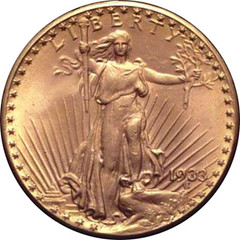 All the confiscated 1933 double eagles were destroyed during the 1950s. I have copies of the destruction certifications which refer to the origin of each coin and the date of its destruction. I also have copies of the confiscation records. Evidently, the Treasury people were convinced that no other examples existed outside the Smithsonian's protection.
Also, see "Illegal Tender" by David Tripp, p.226, for more information on destruction.
All the confiscated 1933 double eagles were destroyed during the 1950s. I have copies of the destruction certifications which refer to the origin of each coin and the date of its destruction. I also have copies of the confiscation records. Evidently, the Treasury people were convinced that no other examples existed outside the Smithsonian's protection.
Also, see "Illegal Tender" by David Tripp, p.226, for more information on destruction.
To read the earlier E-Sylum article, see: QUERY: 1933 SAINT-GAUDENS DOUBLE EAGLE DOCUMENTATION (www.coinbooks.org/esylum_v12n52a15.html)
PHOTO: GREG STEMM AND MATT TUCKER WITH ODYSSEY MARINE TREASURE
Dave Lange, Research Director of Numismatic Guaranty Corporation (NGC) writes:
The latest issue had an article about Odyssey Marine which included a frequently-reproduced photo of Greg Stemm with an unidentified technician. So many times have I seen this photo with only Greg identified in it that I feel compelled to seek justice on behalf of the other individual. That person is Matt Tucker, a conservator with NCS and occasional grader with NGC. Matt deserves his place in history.
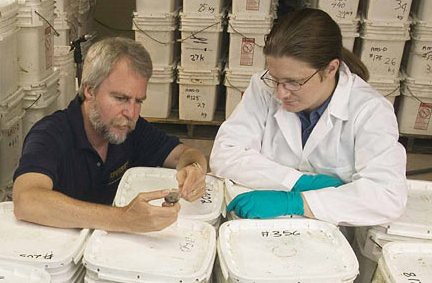
To read the earlier E-Sylum article, see: BOOTY CALL: ODYSSEY MARINE'S BLACK SWAN COINS ORDERED RETURNED TO SPAIN (www.coinbooks.org/esylum_v12n52a19.html)
MORE ON THE PITTSBURG AND MEXICAN TIN MINING COMPANY MEDAL


In the last The E-Sylum, George Fuld wrote:
I just noted the discussion on the H-K 149 Pittsburgh token. I believe the first publication re this "medal" was in our Token Collector pages, in the Numismatist during 1952. It is in the Quarterman "Token Collector Pages" on page 45 along with two other tin mining pieces.
Jonathan Brecher writes:
I was wondering if I could pull up that publication on ine, so I typed a few keywords into Google. It did not find a copy of the 1952 publication, although it did find a mention in the 1953 Numismatist. Unfortunately, that edition is still under copyright and only available in "Snippet view". Someone who has access to hard copies from this era might find more information in volume 66, page 132.
To my surprise it also found a second reference -- from sixty years earlier! My Spanish is a bit rusty, but with the help of Yahoo's Babelfish translator (babelfish.yahoo.com), it appears that George H. Thurston, Secretary of the Pittsburg & Mexican Tin Mining Co, sent a copy of the medal to a Mexican official on January 30, 1892. Too bad he didn't mention how many were struck! (See books.google.com/books?id=7k0UAAAAYAAJ&pg=RA1-PA130&dq=%22first+car+load+of+metallic%22 )
It appears that there is also a mention in 26 AJN 89, but while most volumes of the American Journal of Numismatics are digitized in Google, volume 26 seems to be one of the exceptions.
Ed Krivoniak, whose original question about the medals started this discussion writes:
To read the earlier E-Sylum article, see: MORE ON THE PITTSBURG AND MEXICAN TIN MINING COMPANY MEDAL (www.coinbooks.org/esylum_v12n52a08.html)
E-SYLUM READERS AT BINION'S HORSESHOW CASINO
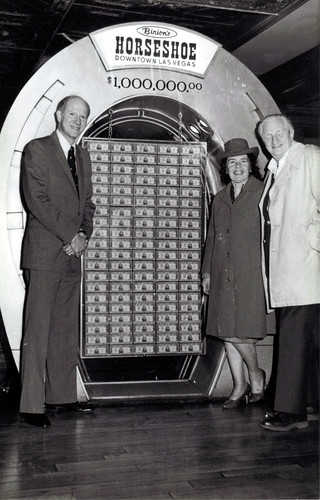 Nick Graver writes:
Nick Graver writes:
The Caseys had formerly operated camera stores in Syracuse and Rochester, NY, and were then established in Liberace Plaza, having their rent collected by the entertainer himself! We went to Binion's for a great steak dinner. All the restaurants and hotels in Las Vegas were partly subsidized by the gambling casinos. Imagine the 'cost' of having the million dollars just sitting there, earning no interest.
Joe Boling writes:
Of course I know that numismatists would be well aware of the difference between gold certificates and Federal Reserve Notes with a gold redemption clause. It was my impression that the popular press was being quoted as saying that the Binion notes were "gold notes," and I was suggesting that the gold clause could well have been interpreted that way by an unversed writer.
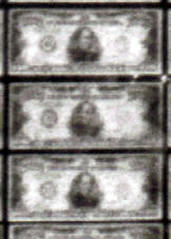 Nick also offers this close-up of the notes he saw, but it's pretty grainy.
His friend Frank Calandra of Rochester forwarded a link to this item on the exhibit.
Nick also offers this close-up of the notes he saw, but it's pretty grainy.
His friend Frank Calandra of Rochester forwarded a link to this item on the exhibit.
Q: Is Binion's new million-dollar display the original $10,000 bills? I thought they sold them.
A: Yes, Becky Behnen, when she took over Binion's Horseshoe more than a decade ago, sold off the hundred $10,000 bills in the original million-dollar display. The new owner of Binion's, Terry Caudill (who also owns the Four Queens across Fremont Street), has put up a new display of a million dollars.
It's displayed in an acrylic pyramid atop a poker table in the center of the casino and consists of $270,000 in $100 bills, $688,000 in $20 bills, and $42,000 in $1 bills. The cash is viewable from 10 am to 10 pm daily; during off hours it's locked under a stainless-steel shell. A Binion's spokesman said that restoring the original display of one-hundred $10,000 bills would have cost $16 million or more
To read the complete article, see: Binion's Horseshoe Hotel-Casino (www.lasvegasmikey.com/binions.htm)
HOW DONATED LAS VEGAS CASINO CHIPS ARE PROCESSED
Dick Johnson writes:It is not well known, particularly those who do not live in Las Vegas that there are more Catholic Churches in Vegas than casinos. It is not a surprise then to learn that some worshipers at Sunday services will drop casino chips in the collection basket. Since they get chips from many different casinos, the churches have devised a method to convert the chips to cash.
The churches send all their collected chips to a nearby Franciscan monastery for sorting and then the chips are taken to the proper casino to be cashed in. This sorting and trips to the casinos are done by the chip monks.
Didn't see that one coming did you?
A PLEA FOR GOLD MONEY
Occasionally I read economic articles for their infrequent mention of coins. I came across this article for its excellent comments on coins and their composition. The author pleads for a return of gold for a circulating coin composition and gold backing of the paper dollar.
Gosh, one doesn't realize how much purchasing power the dollar has lost in the last century. The author is some kind of candidate (I didn't bother to learn for what). Overlook the politics. but read what he says about the coins. Well said.
Dollars are toxic waste in the literal and fiscal sense. Literally, each dollar bill contains arsenic, cadmium, mercury, thallium, and cyanide and generates dumpster upon dumpster of hazardous waste every day. Fiscally, the dollar has lost 98.3% of its value as of January 1, 2010 since the creation of the central bank known as the Federal Reserve in 1913. (Note 1) Many Americans are unaware that the electrons and scraps of linen we trade around as currency are mere shadows of sound money.
To read the complete article, see: Chasing Gelten Shadows (libertymaven.com/2010/01/03/chasing-gelten-shadows/8486/)
THE BOOK BAZARRE
U.S. COIN REPLICAS FROM NEAL SHERMAN'S MARYLAND MINT
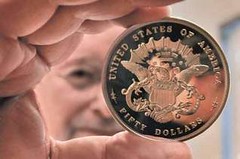 Flip a coin. Go ahead. There's no risk because if you flip a novelty two-headed Morgan silver dollar, produced by The Maryland Mint based in Ocean Pines, you can't lose. Just remember to call "heads."
Flip a coin. Go ahead. There's no risk because if you flip a novelty two-headed Morgan silver dollar, produced by The Maryland Mint based in Ocean Pines, you can't lose. Just remember to call "heads."
Two-headed coins are popular items sold by Maryland Mint owner Neil Sherman, who started the coin reproduction business from his home a few years ago after retiring as a Maryland detective.
For sale are exact replicas of coins, including those rare and valued at thousands of dollars, allowing numismatists to complete collections.
Sherman, a knowledgeable and soft-spoken man with a quick smile, emphasizes The Maryland Mint is not affiliated with the state of Maryland. Coins can be ordered from themarylandmint.com.
His interest in starting a coin reproduction business grew after he bought a reproduction of a coin from The Royal Oak Mint in Michigan. In a typical week, he fills about 50 orders.
Making reproductions is permitted under The Hobby Protection Act, a federal government act. All reproductions have the word "copy," but Sherman buries the word within the design on the coin so it is subtle.
Among reproductions are the rare 1915-S Panama round gold coin and rare 1915-S $50 Panama octagonal gold coin. The coins were made during construction of the Panama Canal. Only 484 were made.
Coin reproductions from 1793 to 2009 are sold, as well as reproductions of the 8-ounce gold bar, popular with collectors who put them on their desks or use them as paperweights.
Sherman, whose business was featured in Coin World magazine, sells wholesale to dealers in Sweden and German and also has dealers in Tennessee, New York City, California and Florida. His coins are in the shop at the Fernbank Museum of Natural History in Atlanta.
They were on the silver screen, too, used in a robbery scene in a movie filmed in Washington, D.C.
His next endeavor is selling coins with business logos on them. Locally, a bank and jewelry store are interested.
The business is enjoyable in retirement, and Sherman called it "the perfect one-man or one-woman business."
To read the complete article, see: When a close-enough coin is good enough (www.delmarvanow.com/article/20091229/OPI06/912290333)
PETER ROSA'S COIN REPLICAS
Web site visitor Charles Doyle of ReplicaCoins Corp. writes:I just came upon your article on Peter Rosa and how he made his coins; most of it is incorrect. I'm also working on a blog to catalog all his early American coins because they are not documented anywhere: www.colonialcoinreplicas-blog.com
Working with Peter Rosa from 1964 until his death in 1990, I'm the last person living that knows what he created and how he made his dies, molds, and coins.
While selling Rosa's ancient coin replicas on eBay I was contacted a number times with questions about the history Rosa's early American coins. I also received Google alerts from the forum CoinTalk, about the authenticity of early American coins that collectors and non-collectors had acquired. Some of these turned out to be Peter Rosa coin replicas.
So I'm starting this blog to document Peter Rosa's vast work of the Colonial and Early American coin reproductions and someday possibility turn it into a reference book. I'm hoping that this will be a worthwhile reference for early American coin collectors and anyone that may have questions about their America colonial coin.
After serving in the Coast Guard during world war two Peter Rosa became a Merchant Marine and would make frequent trips to England from New York on cargo ships. During these trips Peter would visit the British Museum and purchase plaster cast impressions of their ancient Greek, Roman and Early American coins. This was how he was able to amass such a large and diverse collection of beautiful and rare coin impressions.
Peter Rosa and I grew up not far from Yankee Stadium in the south Bronx. He opened Becker Reproductions on 156th street between Melrose and Cortland avenues, and I started working for him there in 1964 at the age of 13.
I have his 1960's Becker Reproductions' production molds, and I'm able to continue to make his coins using the same techniques that we used at Becker Reproductions. I have been selling some of these coins on eBay since 2003.
To read the earlier E-Sylum article, see: MORE ON PETER ROSA COPIES (www.coinbooks.org/esylum_v07n05a14.html)
COIN DEALER TOM NOE'S CONVICTION UPHELD
 Tom Noe's 2006 conviction for stealing millions from Ohio's injured workers' trust fund was upheld by the 6th District Court of Appeals yesterday, with the court ruling that Noe received a fair trial in Toledo.
Tom Noe's 2006 conviction for stealing millions from Ohio's injured workers' trust fund was upheld by the 6th District Court of Appeals yesterday, with the court ruling that Noe received a fair trial in Toledo.
He will remain in the state's Hocking Correctional Facility in Nelsonville, Ohio, where he arrived in 2008, after he finished serving nearly two years in a federal prison in Florida after pleading guilty to making $45,400 in illegal contributions to President Bush's 2004 re-election campaign.
A jury found him guilty of 29 charges of corruption, theft, money laundering, and tampering with records. He was found not guilty on 11 other charges, and several others were dismissed or consolidated.
In April, 2005, The Blade first reported on Noe's $50 million state rare coin investment deal, triggering a multiyear state investigation that uncovered massive corruption in the Ohio Bureau of Workers' Compensation, and led to charges against more than 20 public officials and money managers, including former Ohio Gov. Bob Taft on misdemeanor ethics charges.
To read the complete article, see: Noe's '06 conviction upheld (toledoblade.com/apps/pbcs.dll/article?AID=/20100101/NEWS02/1010343)
PARISIAN ROYAL AGRICULTURAL SOCIETY ATTENDANCE MEDALS
Arthur Shippee writes:This dodgy cell phone picture is of the tag on an exhibit at the Bruce Museum, Greenwich, the object being some medals marking attendance. It's the only medal or coin in this show, but they're nice. The show is about alchemy & chemistry, showing paintings, books, and objects.
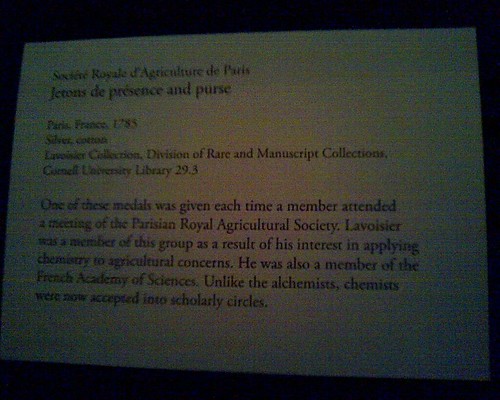
ROMAN COIN FLIPPING: HEADS OR SHIPS
I see in a rather odd article about coin-tossing the Telegraph UK mentions the ancient Roman past-time which they erroneously call Head or Ships but which was actually called Capita vel Navia, Heads or Ships because of Janus, the two headed god (yes, the one January is named after, the god of beginnings).
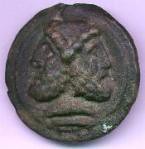
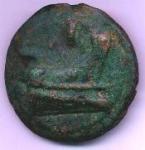
Janus was a very frequent image on coins throughout Roman history but the coin referred to by Macrobius was called the "As" or "Aes Grave". It was a bronze coin that featured Janus on one side and a ship's prow on another. These were typically minted around the Punic Wars (early 3rd century BC) and were replaced eventually by the silver denarius.
To read the complete article, see: Heads or Ships: Roman Coin Flipping (badlatin.wordpress.com/2009/12/31/heads-or-ships-roman-coin-flipping/)
One of the most significant coin tosses in the United State's history involved the naming of the city of Portland, Oregon in 1845. Asa Lovejoy and Francis Pettygrove, who owned the claim to the land that would later become Portland, each wanted to name their new town after their respective hometowns of Boston, Massachusetts and Portland, Maine. Pettygrove prevailed in the coin flip, and the town was named Portland.
In 1903, the Wright brothers flipped a coin to see which one of them would take to the air in the first ever powered flight. Wilbur won the toss but his attempt was only partially successful. Orville's later flight was considered the first example of powered flight.
To read the complete article, see:
Coin tossing through the ages
(www.telegraph.co.uk/science/science-news/6911921/
Coin-tossing-through-the-ages.html)
ROYAL AUSTRALIAN MINT STRIKES CENTENNIAL COIN
 The Royal Australian Mint in Canberra has created the first coin with four heads to mark 100 years of Australian coinage.
The Royal Australian Mint in Canberra has created the first coin with four heads to mark 100 years of Australian coinage.
The $1 coin design honours the four monarchs that have appeared on Australian coins over the past century.
Acting chief executive officer Graham Smith says it commemorates a significant milestone in Australian history.
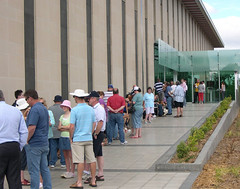 "Along with the new government and Constitution, the change in 1910 from the British monetary system to our own, heralded the unity and budding independence of our young nation," he said.
"Along with the new government and Constitution, the change in 1910 from the British monetary system to our own, heralded the unity and budding independence of our young nation," he said.
"This is what we are celebrating in 2010."
The coin features portraits of King Edward VII, King George V, King George VI and Queen Elizabeth II, and bears the 'C' for Canberra mintmark.
Melbourne coin collector Bruce Mansfield lined up for 18 hours to be first person to strike the new coin.
To read the complete article, see: Heads or tails? Celebrating 100yrs of coinage (www.abc.net.au/news/stories/2010/01/01/2783905.htm?section=australia)


QUERY: JOSEPH WHARTON MEDALS
Joseph Wharton was a major 19th century industrialist credited with producing the first metallic zinc and the first metallic nickel in America. He was also was one of the founders of both the International Nickel Co. and Bethlehem Steel. He also founded the Wharton School of Business at the University of Pennsylvania.
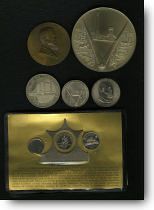 There are several medals featuring Wharton, including a common So-Called Dollar (HK-323) and a slightly less common award medal, both pictured in a Heritage sale a couple of years ago.
There are several medals featuring Wharton, including a common So-Called Dollar (HK-323) and a slightly less common award medal, both pictured in a Heritage sale a couple of years ago.
Attached are pictures of a different medal related to Joseph Wharton, showing his parents William Wharton and Deborah Fisher Wharton. It is 53.4 mm, 54.9 g, and unsigned. I have not been able to locate any information about this medal, and I wonder if any of the readership might have seen it before.
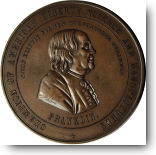 This medal bears some obvious similarities to a well-know-but-rare medal featuring Benjamin Franklin. That medal, produced by prolific medallist Robert Lovett Jr., is pictured at Heritage, and also in the ANS collection.
This medal bears some obvious similarities to a well-know-but-rare medal featuring Benjamin Franklin. That medal, produced by prolific medallist Robert Lovett Jr., is pictured at Heritage, and also in the ANS collection.
The wording on the reverse is identical to this one, but from a totally different die. Compared to the Franklin medal, parts of the William Wharton medal show high quality. The letters are nicely squared off, and it clearly had nice reflective surfaces to start with. But parts have low quality. Many of the letters on the reverse of the William Wharton medal are recut or repunched, some of them drastically. The portraits show linear dotted marks throughout that I'm going to say (waving my hands) might be un-cleaned-up evidence of using some sort of reducing machine during the production of the dies. In short, the William and Deborah Wharton medal doesn't have the feel of "Lovett quality".
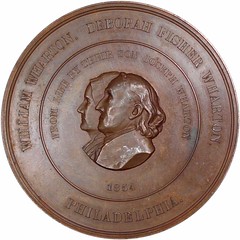
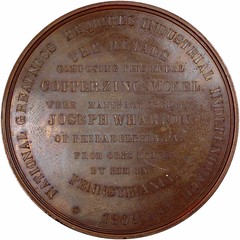
In trying to find any information about this medal, I came across one reference that might be relevant -- or that might confuse the issue further. On February 18, 1895, Horatio Robinson Storer read a paper before the Newport Historical Society describing the medals of Rhode Island. Item 120 in that paper is a medal described as "Joseph Wharton, summer resident at Jamestown, R.I. Bronze. 53mm. By R. Lovett." .
That medal is probably related to this one, but is it the same piece? It seems that this medal would best be described as portraying William and Deborah Wharton. Similarly, the Franklin medal would best be described as portraying Franklin. Was Storer describing one of those, or possibly a third piece that really does portray Joseph?
Any information about this William and Deborah Wharton medal would be welcomed.
E-Sylum readers might want to take a close look at that Storer paper for a different reason. Storer documents the original recipients and current locations (as of 1895) of several gold US Mint medals, information that I have never seen before.
The Nathaniel Green medal in gold, presumably referring to Julian MI-10, was "in the possession of Mr. W. Brenton Greene, of Newport."
Storer could not locate the gold version of the Oliver Hazard Perry medal, presumably referring to Julian NA-17. One of the silver strikings, however, he documents, "was conferred on Acting Surgeon Usher Parsons, U. S. N., of Providence, and is now in the possession of his nephew, Mr. Edwin Parsons of N. Y.
A "Medal to Perry from the State of Pennsylvania", in gold, was "owned by Mr. O. H. Perry of Lowell, Mass." That was probably one of NA-18 through NA-21. Of those, Julian states that only NA-20 was struck in gold, and that it is now in the United States Naval Academy Museum at Annapolis.
"One of the silver Congressional medals for battle between the ships Hornet and Peacock was conferred on Acting Surgeon Charles Cotton, U. S. N., of Newport, and is now in the possession of his son, Mr. William H. Cotton." That presumably refers to the Captain James Lawrence medal, Julian NA-14.
The original gold versions of the medal for the wreck of the Steamer Metis (Julian LS-15) were "owned by the families of Capt. Jared S. Crandall, Albert Crandall, Daniel F. Larkin, Frank Larkin, Byron Green, John D. Harvey, Courtland Gavitt, Eugene Nash, Edwin Nash, and Wm. Nash, of Westerly, the life savers, who are all now dead." That totals ten recipients, which exactly matches the mintage reported by Julian.
...and a host of other information about additional pieces with ties to Rhode Island.
It sure would be interesting to try to track down where some of those pieces are now!
THE BOOK BAZARRE
ZIMBABWE NOTES IN THE NEWS AGAIN
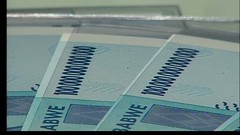 A local exchange shop has gotten its hands on eight hundred trillion dollars in Zimbabwe money.
A local exchange shop has gotten its hands on eight hundred trillion dollars in Zimbabwe money.
"Hundred trillion dollar bank note from Zimbabwe. It's in a third issue of four and it was replaced in June," Ram Z's floor manager Chad Ramsey said.
Because of inflation, the one hundred trillion dollar note at Ram Z's Exchange might be able to buy you breakfast.
"It was at the time only worth about 33 cents," Ramsey said. "They really don't have any value. Just for the nostalgia of having a bill that is just a hundred trillion dollar bill."
Randy Ramsey said there have been many customers coming into Ram Z's to buy and invest in gold and silver because of their fear of inflation in the United States.
" In the last year, we have had people coming in, some come in on a weekly basis, to buy a piece of gold, to buy a piece of silver. And other people are able to buy larger quantities. I think it is an indication with their concerns as well for our U. S. Dollar, printing so much with out much to back it," Randy said.
To read the complete article, see: Store gets trillion dollar banknote (www.wlfi.com/dpp/on_the_money/Copy_of_local-exchange-store-gets-its-hands-on-a-trillion-dollars)
To read the earlier E-Sylum article, see: BARBER GETS 100 TRILLION DOLLAR TIP (www.coinbooks.org/esylum_v12n52a20.html)
GOT CHANGE FOR A MILLION SILVER DOLLARS?
Werner Talso writes:
I thought your readers might be interested in this news story in the German magazine "Der Speigel". I guess all Europeans do not really understand our monetary system.
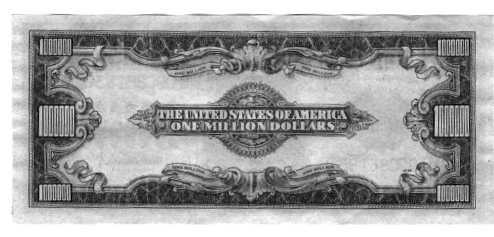
Two Germans were caught in an Austria mountain town with 500 million dollars in counterfeit banknotes. It's one of the biggest hauls of counterfeit dollars in Europe. But the culprits say they thought the 1 million dollar bills were real. Early next year an Austrian court must decide their fate.
At the end of January, Hölzen will face trial in a district court in Feldkirch, in Austria's Vorarlberg region. Austrian prosecutors have filed charges against him and his accomplice, Dietmar B., 52, for attempted fraud and possession of counterfeit banknotes.
Almost a year ago, Hölzen and B. were arrested in a bank in Austria's Kleinwalsertal ski valley. The duo stands accused of having attempted to exchange $202 million in counterfeit bills. The police also found $291 million more in counterfeit bills in a black Samsonite suitcase the men were carrying.
Technically speaking, it was one of the biggest successes that European police organizations have ever had in the fight against counterfeit US banknotes. But not even the Austrian police are willing to call it a coup. And that's because the defendants lacked both a plan and any professionalism.
Instead, the trial in Feldkirch is more likely to offer a cautionary tale about how, in greedy times, even ordinary people think there is a fast track to wealth. And about how they believed that they could get rich quick through a combination of cunning and a few printed piece of paper; And how they ruined their lives in the process.
Two men walked into his office one afternoon. One of them, Hendrik van den B., a tall, gaunt older man, was wearing a dark, expensive-looking suit and introduced himself as a Dutch businessman. He looks as though he has money, Hölzen said to himself.
The other man, short and bald, was Dietmar B., from Essen in western Germany who looked much less imposing. According to Hölzen, what B. did not tell him was that he was a machinist, who had been unemployed for a long time and that he had already served prison time for attempted fraud and for his association with a criminal gang that was involved in grand larceny.
The men told Hölzen that he had been recommended to them by a former client and that they wanted him to prepare a purchase agreement for some historic stocks, some of which were American silver certificates. They told him that these silver certificates, which closely resembled ordinary dollar bills, were never used as a conventional form of payment but were traded between banks in the past. And they remained extremely valuable.
An employee with Julius Bär, a Swiss private bank, promptly replied that the pieces of paper were worthless. But Hölzen did not want to hear this. This deal of a lifetime couldn't possibly be over before it had even begun, he thought. "This is my big chance," he kept telling himself.
That is Hölzen's side of the story anyway. "I was naïve," he admits -- and that is all he will admit too. He continues to insist that he was not the main instigator of the crime with which he is now being charged.
The eventual case, when it comes to court, will revolve around whether the two Germans believed that the banknotes were real or whether they were deliberately trying to unload counterfeit bills. The investigators claim that by the time they reached the bank in Riezlern, Hölzen and B. "had come to terms with the possibility that the banknotes could be counterfeit."
To read the complete article, see: Got Change For A Million Silver Dollars? (www.spiegel.de/international/germany/0,1518,669480,00.html)
MALAYSIAN BANKNOTE ERROR DISCOVERED
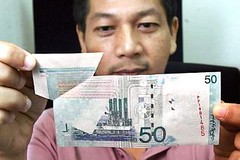 SOME avid collectors of ringgit notes with print defects would probably be interested in owning a RM50 note which was withdrawn from an ATM at the Penang International Airport.
SOME avid collectors of ringgit notes with print defects would probably be interested in owning a RM50 note which was withdrawn from an ATM at the Penang International Airport.
The legal tender was found stuck among 20 pieces of RM50 notes which was withdrawn by remisier Norhazi Ismail, 45, at about noon yesterday.
Bearing the serial number, ‘PP1981485' on the back, the note had an extra flap on the front left top corner.
"This banknote is legal as it came straight from Maybank. Also the paper quality, serial number, photo of the Agung and watermark are all intact," he said.
Norhazi, a former bank worker, said this was the second time he had found such a note.
"In 1984, when I was working in the then Southern Bank in Bayan Lepas, I received the old RM100 note which had two faces of the King on it.
Norhazi said he would keep both the ringgit notes as he felt they might be collector's items one day.
To read the complete article, see: Money – and more (thestar.com.my/news/story.asp?file=/2009/12/30/nation/5384240)
AMAZON'S KINDLE MILESTONE: MORE E-BOOKS THAN REAL BOOKS SOLD ON CHRISTMAS
Amazon's Kindle hit an important and startling milestone yesterday: On Christmas, the company sold more Kindle books than physical books. Yes, this is obviously the result of everyone who got a Kindle for Christmas (lots of folks) firing it up and ordering a bunch of eBooks on a day in which most physical-book readers weren't shopping. But it's still important and impressive.
To read the complete article, see:
Kindle Milestone: Amazon Sold More Kindle Books Than Physical Books On Xmas
(www.businessinsider.com/henry-blodget-kindle-milestone
-amazon-sold-more-ebooks-than-physical-books-on-xmas-2009-12)
FUNKY BOOKSHELVES

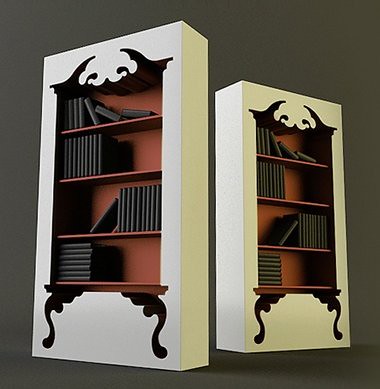
To read the complete article, see: Design Porn: Bookshelves (flavorwire.com/51509/design-porn-bookshelves)
FEATURED WEB PAGE: THE NEW YORK NUMISMATIC CLUB YEAR BOOK
This week's Featured Web page is suggested by John and Nancy Wilson who write:
While researching W. W. C. Wilson we came across this site. It has very valuable information regarding the New York Numismatic Club.
What they found was a digitized version of THE NEW YORK NUMISMATIC CLUB YEAR BOOK 1918-1919-1920-1921. It's a crudely OCR'd copy (in one place the club's name is spelled TMUMISMATIC), but still usable for research. Here are two excerpts.
The New York Numismatic Club was organized as a social organization by a number of collectors and others interested in Numismatics, at Keen's Chop House in 36th Street, New York City, on December 11, 1908. Subsequently on December 3rd, 1909, the Club was incorporated under the laws of the State of New York. Its first officers were elected at the first meeting of the Club, and annual elections provided for new administrative officials every year. The following is a brief summary of the principal executive officers who have guided the activities of the New York Numismatic Club during the fourteen years of its successful and prosperous existence.
By Mr. Proskey: The question having been raised as to the ability of our American die-sinkers to design coins equal to those of other countries, this exhibitor endeavored to show that the United States Mint pattern for coins in past decades indicate that our artists have equalled and excelled those of foreign countries of the same periods, but our officials have not selected competent judges to select the best or most beautiful designs from the many patterns made in the mint, as may be proved by our currency since about 1840, the ugliest having always been selected, with very few exceptions.
www.archive.org/stream/yearbook05unkngoog/
yearbook05unkngoog_djvu.txt
